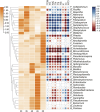Effects of different fermentation temperatures on microbiomes of cigar tobacco leaves
- PMID: 40070551
- PMCID: PMC11893599
- DOI: 10.3389/fbioe.2025.1550383
Effects of different fermentation temperatures on microbiomes of cigar tobacco leaves
Abstract
Introduction: Microbiomes of cigar tobacco leaves play a pivotal role during the fermentation, and fermentation temperature is a key factor in shaping the structure and function of the microbial community. This study aimed to investigate the effects of different temperatures (30°C, 35°C, 40°C, 45°C, and 50°C) on the microbiomes of cigar tobacco leaves, providing insights into the complex interactions among temperature, microbes, and physicochemical metabolites.
Methods: Firstly, the physicochemical metabolites of cigar tobacco leaves under various fermentation temperatures were detected by gas chromatography-mass spectrometry. Subsequently, the impacts of different temperatures on microbial biomass and community structure were revealed by quantitative real-time PCR and amplicon sequencing, and the biomarkers at different fermentation temperatures were identified by LEfSe analysis. Finally, the functional potential of microbes was predicted by correlation analysis.
Results: The bacterial biomass increased initially and peaked at 8.4 × 109 copies/g at 35°C, then decreased as the temperature rose. The fungal biomass exhibited a downward trend with increasing temperature, reaching a maximum of 3.9 × 106 copies/g at 30°C. When the fermentation temperature exceeded 45°C, the growth of both bacteria and fungi was significantly restricted. Amplicon sequencing results indicated that Staphylococcus and Aspergillus genera dominated the bacterial and fungal communities, respectively. As the temperature increased, the relative abundance of Staphylococcus decreased first and then increased (46.1%-98.5%), while that of Aspergillus increased first and then decreased (34.9%-77.4%). Additionally, correlation analysis suggested that microbial communities shaped by different temperatures were responsible for the differences in physicochemical metabolites of cigar leaves. The biomarkers identified in the low-temperature fermentation group, including Staphylococcus, Stemphylium, Sampaiozyma, and Filobasidium, were likely responsible for the production of flavor metabolites, the accumulation of sugars, and the elevated ratio of potassium ions to chloride ions contents. Biomarkers in medium and high-temperature fermentation groups, such as Aspergillus, Neodymella, Acinetobacter, Pelomonas, Brevundimonas, and Alkalihalobacillus, might contribute to the degradation of nitrogen-containing substances and alkaloids.
Discussion: This study revealed the unique microbial community structure shaped at different temperatures and its potential correlation with physicochemical metabolites. These findings will help to further optimize the fermentation process of cigar tobacco leaves and develop functional microorganisms suitable for different fermentation temperatures.
Keywords: cigar tobacco leaves; fermentation temperature; microbial community structure; microbial functions; physicochemical metabolites.
Copyright © 2025 Jia, Guo, Hu, Zhang, Wang, Zhang, Chai and Li.
Conflict of interest statement
Authors YJ, SG, WH, QZ, YW, ZZ, ZC, and DL were employed by China Tobacco Sichuan Industrial Co., Ltd.
Figures









References
LinkOut - more resources
Full Text Sources
Research Materials

